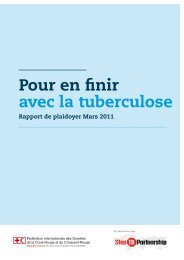Thailand - Stop TB Partnership
Thailand - Stop TB Partnership
Thailand - Stop TB Partnership
Create successful ePaper yourself
Turn your PDF publications into a flip-book with our unique Google optimized e-Paper software.
Prison populations<br />
<strong>TB</strong> prevalence is markedly higher in prisons than in the general population. In one Bangkok<br />
prison, the prevalence of new smear-positive cases was 1,226 per 100,000. 104<br />
In October 1998, the NTP, MoPH, and the Ministry of Justice initiated a collaborative<br />
effort to ensure implementation of the DOTS strategy in 11 prisons in Bangkok and<br />
nearby provinces. 105 This effort, which involved working with prison <strong>TB</strong> clinical staff to<br />
ensure close adherence to the DOTS strategy, 106 has posted a high treatment success rate<br />
(68.7 percent from June 1999 to May 2002), and has been cited by the WHO as a model<br />
for other countries. 107 The NTP’s successful prison outreach project should be expanded to<br />
improve the system for follow-up with people after they have been released from prison.<br />
According to one official, the biggest challenge to the success of the prison program<br />
is the follow-up with people after they are released from prison. 108 The system for<br />
transferring cases from prison clinics to public clinics is inefficient. Treatment for people<br />
newly released is more likely to be interrupted or even discontinued, especially as many former<br />
prisoners reportedly fail to show up at the hospitals to which they are directed, provide<br />
false contact names and addresses, or just disappear. 109 NTP research on the reasons people<br />
released from prison discontinue treatment should be used to develop a more streamlined<br />
policy to ensure proper referral and follow-up. 110<br />
<strong>TB</strong> and poverty<br />
There is abundant evidence that poverty increases vulnerability to <strong>TB</strong>, and that having <strong>TB</strong><br />
can in turn make patients more vulnerable to poverty. According to a recent study, for those<br />
with incomes at or below the poverty line, out-of-pocket expenditure for diagnosis and treatment<br />
amounted to more than 15 percent of annual household income while incomes were<br />
reduced by an average of 5 percent. 111 While <strong>TB</strong> treatment is free, travel to medical facilities,<br />
lack of compensation for time off from work, purchase of food during hospital visits, and<br />
diagnostic services such as x-rays and sputum examinations (for which patients are often<br />
charged, despite official NTP policy) add up to expenses that may limit access to treatment<br />
for the poor. (According to official NTP policy, patients have to pay for diagnostic and examination<br />
services only if they can afford it.)<br />
Some regional clinics reportedly provide subsidies to <strong>TB</strong> patients living in poverty,<br />
but the funds available for these efforts have been gradually decreasing since the health care<br />
reforms were enacted. 112 To increase treatment access for the poor, the government should<br />
consider providing subsidized support on the basis of need to cover incidental expenses<br />
such as transportation costs and meals.<br />
54<br />
<strong>TB</strong> POLICY IN THAILAND



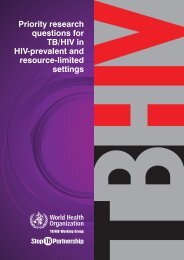
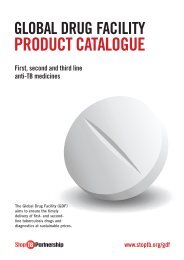
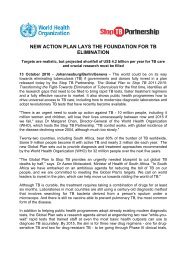
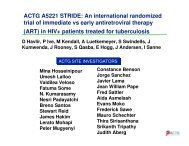
![Global Drug Facility Annual Report 2011 [.pdf] - Stop TB Partnership](https://img.yumpu.com/26788745/1/184x260/global-drug-facility-annual-report-2011-pdf-stop-tb-partnership.jpg?quality=85)

![Concept note on national stop TB partnership [.pdf]](https://img.yumpu.com/26788741/1/184x260/concept-note-on-national-stop-tb-partnership-pdf.jpg?quality=85)
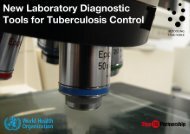

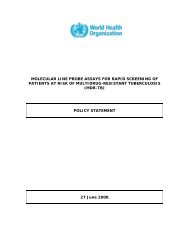
![2005 and Challenges for 2006 - 2015 [.pdf] - Stop TB Partnership](https://img.yumpu.com/26788674/1/190x245/2005-and-challenges-for-2006-2015-pdf-stop-tb-partnership.jpg?quality=85)
![Brochure (French) [.pdf] - Stop TB Partnership](https://img.yumpu.com/17234792/1/190x91/brochure-french-pdf-stop-tb-partnership.jpg?quality=85)

